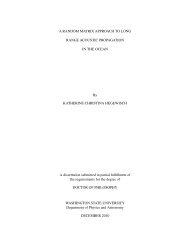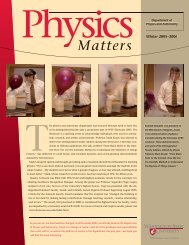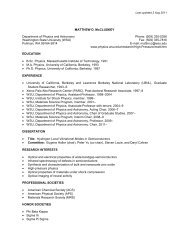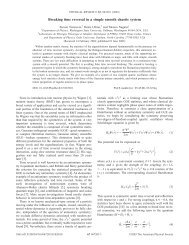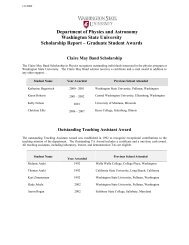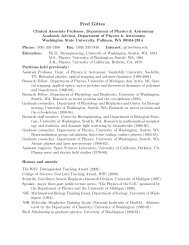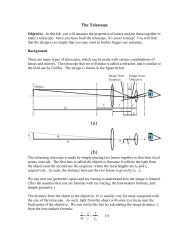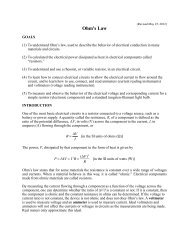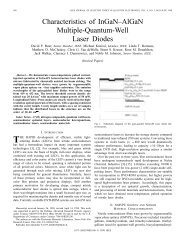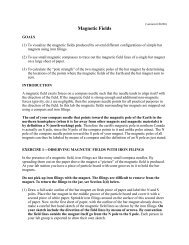Infrared spectroscopy of biphenyl under hydrostatic pressure
Infrared spectroscopy of biphenyl under hydrostatic pressure
Infrared spectroscopy of biphenyl under hydrostatic pressure
Create successful ePaper yourself
Turn your PDF publications into a flip-book with our unique Google optimized e-Paper software.
JOURNAL OF CHEMICAL PHYSICS VOLUME 117, NUMBER 8 22 AUGUST 2002<br />
<strong>Infrared</strong> <strong>spectroscopy</strong> <strong>of</strong> <strong>biphenyl</strong> <strong>under</strong> <strong>hydrostatic</strong> <strong>pressure</strong><br />
K. K. Zhuravlev<br />
Department <strong>of</strong> Physics, Washington State University, Pullman, Washington 99164-2814<br />
M. D. McCluskey<br />
Department <strong>of</strong> Physics and Institute for Shock Physics, Washington State University, Pullman,<br />
Washington 99164-2814<br />
Received 22 April 2002; accepted 29 May 2002<br />
Changes in the conformations <strong>of</strong> conjugated molecules affect the optical and electronic properties<br />
significantly. Hydrostatic <strong>pressure</strong> has been used to probe the conformations <strong>of</strong> <strong>biphenyl</strong> (C 12 H 10 )<br />
and deuterated <strong>biphenyl</strong> (C 12 D 10 ) at liquid-helium temperatures. <strong>Infrared</strong> IR spectra <strong>of</strong> these<br />
materials have been taken up to a <strong>pressure</strong> <strong>of</strong> 2 GPa. A disappearance <strong>of</strong> certain IR absorption peaks<br />
has been found to occur between 0.07 and 0.45 GPa, due to the phase transition from a twisted to<br />
a planar conformation. Numerical simulations together with group-theoretical analysis have been<br />
performed to identify the nature <strong>of</strong> the vibrational modes that lose IR activity upon planarization.<br />
© 2002 American Institute <strong>of</strong> Physics. DOI: 10.1063/1.1494776<br />
I. INTRODUCTION<br />
With the recent advances in organic light-emitting<br />
diodes 1 and lasers, 2 organic materials have received attention<br />
for optoelectronic device applications. In conjugated polymers,<br />
the -electrons are delocalized along the molecule,<br />
resulting in band gaps in the visible region <strong>of</strong> the spectrum.<br />
The conformations <strong>of</strong> conjugated molecules affect the optical<br />
properties significantly. 3 As molecules transform from<br />
twisted to planar conformations, the overlap between -<br />
electrons on neighboring rings increases, resulting in a redshift<br />
<strong>of</strong> the band gap. The application <strong>of</strong> <strong>hydrostatic</strong> <strong>pressure</strong><br />
is an excellent means for probing the vibrational, structural,<br />
and optical properties <strong>of</strong> conjugated molecules. 4 Raman<br />
<strong>spectroscopy</strong> has been used to investigate the planarization<br />
<strong>of</strong> para-hexaphenyl. 5,6 Combined experimental and computational<br />
studies <strong>of</strong> <strong>biphenyl</strong> showed a redshift in the optical<br />
spectra due to conformational changes. 7<br />
Polyphenyl molecules, such as <strong>biphenyl</strong>, <strong>under</strong>go a<br />
phase transition in which the molecules transform from a<br />
twisted to a planar conformation. In <strong>biphenyl</strong>, the phase transition<br />
has been studied by the methods <strong>of</strong> electronic absorption<br />
and emission; 8 neutron, 9 x-ray, 10 Brillouin, 11 and Raman<br />
scattering; 12 nuclear magnetic 13 and electron paramagnetic<br />
resonance. 14 In these studies it was found that such a transition<br />
occurs when either temperature 8–11,13 or <strong>pressure</strong> 12 rises<br />
above certain critical values. In Ref. 12, however, only torsional<br />
lattice modes were observed experimentally. In the<br />
present work we analyze the behavior <strong>of</strong> the internal hydrogen<br />
modes in <strong>biphenyl</strong> <strong>under</strong> <strong>pressure</strong>.<br />
It is now known that the <strong>biphenyl</strong> has, in fact, two incommensurate<br />
phases, II and III. In both <strong>of</strong> these phases, the<br />
phenyl rings are twisted, 15–17 but the angle <strong>of</strong> the twist is<br />
modulated through the crystal structure. The difference between<br />
the modulation vectors distinguishes the two phases.<br />
At atmospheric <strong>pressure</strong> the transition from high-temperature<br />
phase I to phase II occurs at T40 K, and from phase II to<br />
phase III at T17 K. The critical <strong>pressure</strong>s at liquid helium<br />
temperatures are approximately 0.18 and 0.05 GPa, respectively.<br />
Our experimental technique is sensitive to the transition<br />
from phase II to phase I, when the molecules transform<br />
from a twisted to a planar conformation. This <strong>pressure</strong>induced<br />
‘‘flattening’’ leads to the novel observation that certain<br />
peaks in the IR spectrum disappear.<br />
Recently we reported the flattening <strong>of</strong> para-quaterphenyl<br />
<strong>under</strong> <strong>hydrostatic</strong> <strong>pressure</strong>, and the transition point was determined<br />
to be between 0.7 and 1 GPa at liquid-helium<br />
temperatures. 18 The phase transition in para-quaterphenyl resulted<br />
in the disappearance <strong>of</strong> five infrared IR absorption<br />
peaks in the spectral range corresponding to hydrogen out<strong>of</strong>-plane<br />
bending modes. A group-theory analysis supported<br />
the supposition that certain IR peaks disappear upon planarization.<br />
However, there was an uncertainty about the character<br />
<strong>of</strong> motion <strong>of</strong> atoms within the molecule for those<br />
modes that lose IR activity in the planar conformation.<br />
In order to resolve these problems, a new series <strong>of</strong> experiments<br />
was performed on <strong>biphenyl</strong> and deuterated <strong>biphenyl</strong>.<br />
The substitution with deuterium provides additional<br />
spectroscopic information, in order to determine the exact<br />
identities <strong>of</strong> the vibrational modes. One may expect that a<br />
<strong>biphenyl</strong> molecule <strong>under</strong> <strong>pressure</strong> behaves similarly to that<br />
<strong>of</strong> para-quaterphenyl. The smaller number <strong>of</strong> atoms in <strong>biphenyl</strong>,<br />
as compared to para-quaterphenyl, is advantageous for<br />
ab initio calculations. In this paper, experimental and grouptheoretical<br />
results for <strong>biphenyl</strong> and deuterated <strong>biphenyl</strong> are<br />
presented, as well as the results <strong>of</strong> numerical simulations <strong>of</strong><br />
the IR spectra for these molecules.<br />
II. EXPERIMENT<br />
To generate <strong>pressure</strong>s up to 2 GPa, we used a pistoncylinder<br />
diamond-anvil cell. 19 Type-I diamonds with culet<br />
diameters <strong>of</strong> 700 m were used. After a 250-m thick stainless<br />
steel gasket was indented to a thickness <strong>of</strong> 100 m, a<br />
340-m diam hole was drilled in the center <strong>of</strong> the indentation.<br />
Nitrogen was used as a <strong>pressure</strong> medium and was<br />
loaded into the gasket hole, along with the sample, by liquid<br />
immersion. 20 To determine the <strong>pressure</strong> at liquid helium tem-<br />
0021-9606/2002/117(8)/3748/5/$19.00 3748<br />
© 2002 American Institute <strong>of</strong> Physics<br />
Downloaded 23 Dec 2005 to 134.121.128.99. Redistribution subject to AIP license or copyright, see http://jcp.aip.org/jcp/copyright.jsp
J. Chem. Phys., Vol. 117, No. 8, 22 August 2002 Spectroscopy <strong>of</strong> <strong>biphenyl</strong><br />
3749<br />
FIG. 1. a–b Absorption spectra <strong>of</strong> <strong>biphenyl</strong> below and above the phasetransition<br />
<strong>pressure</strong>, at a temperature <strong>of</strong> 8 K.<br />
FIG. 2. a–b Absorption spectra <strong>of</strong> deuterated <strong>biphenyl</strong> below and above<br />
phase-transition <strong>pressure</strong>, at a temperature <strong>of</strong> 8 K.<br />
peratures, we measured the IR absorption peak <strong>of</strong> the 3<br />
vibrational mode <strong>of</strong> isolated carbon dioxide impurities in the<br />
solid nitrogen matrix. 21<br />
Mid-IR absorption spectra were obtained with a Bomem<br />
DA8 vacuum Fourier transform IR spectrometer with a KBr<br />
beamsplitter. The samples were kept at a temperature <strong>of</strong> 8 K<br />
in a Janis continuous-flow liquid-helium cryostat with<br />
wedged zinc selenide windows. The spectral range was 500–<br />
5000 cm 1 and the instrumental resolution was 2 cm 1 . The<br />
type-I-diamond absorption band prevented measurements between<br />
1100 and 1400 cm 1 . An <strong>of</strong>f-axis parabolic mirror and<br />
light-concentrating cone focused the light through the first<br />
diamond and onto the sample. The light then passed through<br />
the second diamond and onto a Ge:Cu photoconductor detector.<br />
After a spectrum was measured, the diamond-anvil cell<br />
was warmed to room temperature and the <strong>pressure</strong> was adjusted.<br />
Two samples were investigated. First, protreated <strong>biphenyl</strong><br />
(C 12 H 10 ), hereafter referred to simply as <strong>biphenyl</strong>, was<br />
measured. Second, deuterated <strong>biphenyl</strong> (C 12 D 10 ), or<br />
<strong>biphenyl</strong>-d 10 , was measured. In the latter sample, every hydrogen<br />
was replaced by a deuterium, with an isotopic purity<br />
<strong>of</strong> 98%. 22 The IR spectra for <strong>biphenyl</strong> are shown in Fig. 1<br />
and spectra for deuterated <strong>biphenyl</strong> are shown in Fig. 2.<br />
Peaks that disappear at high <strong>pressure</strong>s are indicated by<br />
arrows. The spectral range from 500 to 1100 cm 1 corresponds<br />
to out-<strong>of</strong>-plane motion <strong>of</strong> hydrogen atoms in which<br />
the atomic displacement is perpendicular to the plane <strong>of</strong> the<br />
appropriate ring. There are three peaks in the <strong>biphenyl</strong> spectrum<br />
in the range 500–800 cm 1 that disappear upon the<br />
phase transition Fig. 1a. The spectral range from 1100 to<br />
1800 cm 1 includes in-plane hydrogen bending modes. Upon<br />
substitution with deuterium, hydrogen-related frequencies<br />
should decrease by some factor, which in an ‘‘ideal’’ case is<br />
&. From Fig. 2a it is seen that there are two peaks, at 545<br />
and 655 cm 1 , that disappear in deuterated <strong>biphenyl</strong>. Relative<br />
to the hydrogen peaks at 679 and 790 cm 1 Fig. 1a,<br />
the deuterium peaks are shifted downward by a factor less<br />
than &. The deviation from the ideal case is due to anharmonic<br />
effects as well as significant motion <strong>of</strong> the carbon<br />
atoms. In the observed spectra the strongest peaks were<br />
found to be due to out-<strong>of</strong>-plane hydrogen motion.<br />
The <strong>pressure</strong>-dependent shifts <strong>of</strong> several out-<strong>of</strong>-plane<br />
hydrogen bending modes are plotted for <strong>biphenyl</strong> in Fig. 3.<br />
In Fig. 4 we plotted the normalized intensities for two peaks<br />
that disappear after the phase transition, as a function <strong>of</strong><br />
<strong>pressure</strong>. The intensity <strong>of</strong> the peak at approximately 836<br />
cm 1 was chosen as a reference for the normalization. At a<br />
<strong>pressure</strong> between 0.07 and 0.4 GPa, the integrated absorbance<br />
<strong>of</strong> the peaks at 790 and 841 cm 1 drops to zero, to<br />
within experimental uncertainty. Our results are in agreement<br />
with those <strong>of</strong> Ref. 12, which reported a phase transition at<br />
0.18 GPa.<br />
III. GROUP THEORY<br />
To explain the disappearance <strong>of</strong> IR activity for certain<br />
vibrational modes, we applied group theory to analyze the<br />
Downloaded 23 Dec 2005 to 134.121.128.99. Redistribution subject to AIP license or copyright, see http://jcp.aip.org/jcp/copyright.jsp
3750 J. Chem. Phys., Vol. 117, No. 8, 22 August 2002 K. K. Zhuravlev and M. D. McCluskey<br />
FIG. 3. Frequency shifts <strong>of</strong> four <strong>biphenyl</strong> peaks, corresponding to hydrogen<br />
out-<strong>of</strong>-plane bending modes, as a function <strong>of</strong> <strong>pressure</strong>.<br />
normal vibrational modes <strong>of</strong> the molecules. The z-axis in our<br />
analysis is directed along the main axis <strong>of</strong> the molecule, the<br />
x-axis is in the molecular plane for the planar conformation,<br />
and the y-axis is perpendicular to the plane. A schematic<br />
diagram <strong>of</strong> <strong>biphenyl</strong> in its twisted conformation is shown in<br />
Fig. 5a. The twisted conformation <strong>of</strong> <strong>biphenyl</strong> belongs to<br />
the D 2 point group. The vibrational modes can be classified<br />
as follows:<br />
15A 13B 1 16B 2 16B 3 .<br />
Modes belonging to the B 1 , B 2 ,orB 3 irreducible representations<br />
are IR-active, for a total <strong>of</strong> 45 IR-active modes. For<br />
the planar configuration, <strong>biphenyl</strong> belongs to the D 2h point<br />
group. The vibrational modes are given by<br />
11A g 4A u 3B 1g 10B 2g 6B 3g<br />
10B 1u 6B 2u 10B 3u .<br />
Modes belonging to the B 1u , B 2u ,orB 3u irreducible representations<br />
are IR-active, for a total <strong>of</strong> 26 IR-active modes.<br />
Upon planarization, some <strong>of</strong> the B 1 , B 2 , and B 3 modes<br />
transform into B 1g , B 2g , and B 3g modes, which are IRinactive.<br />
This disappearance <strong>of</strong> certain IR absorption peaks is<br />
in qualitative agreement with our experimental observations.<br />
In our previous work, we proposed two models. 18 The<br />
first model assumed that there are only nearest-neighbor or<br />
FIG. 4. Normalized intensities <strong>of</strong> two modes that lose IR activity upon<br />
planarization.<br />
FIG. 5. a Schematic diagram <strong>of</strong> the <strong>biphenyl</strong> molecule in the twisted<br />
conformation. The solid hexagons represent phenyl rings. b Schematic<br />
diagram <strong>of</strong> one out-<strong>of</strong>-plane hydrogen bending mode, that becomes IRinactive<br />
upon planarization.<br />
next-nearest-neighbor interactions between hydrogen atoms.<br />
From this assumption, it follows that certain IR modes would<br />
be degenerate. In the case <strong>of</strong> <strong>biphenyl</strong>, there would be three<br />
peaks that disappear in the IR spectrum, two B 1 modes and<br />
one B 3 mode. In the twisted conformation, B 1 modes induce<br />
a dipole moment along z-axis. In the second model, the disappearing<br />
modes are assumed to belong to either B 2 or B 3<br />
representations, which have induced dipole moments along<br />
the y- and x-axis, respectively. Such modes would have<br />
greater intensities than the B 1 modes, due to the larger induced<br />
dipole moments. As shown in the next section, our<br />
calculations tend to support the second model.<br />
In Fig. 5b, one <strong>of</strong> the B 3 modes is shown schematically.<br />
The cross sections <strong>of</strong> the phenyl rings are represented<br />
as rectangles and the dipole moments, induced by the motion<br />
<strong>of</strong> hydrogen atoms, are shown by the arrows. In the twisted<br />
conformation, the mode has a net induced dipole moment in<br />
the x-direction. In the planar conformation, the dipoles exactly<br />
cancel, so that the mode is IR-inactive.<br />
IV. NUMERICAL ANALYSIS<br />
Ab initio calculations are used extensively to model molecular<br />
and atomic systems. Some recent calculations <strong>of</strong> the<br />
<strong>biphenyl</strong> structure can be found in Refs. 23 and 24. We also<br />
performed ab initio calculations in order to simulate the IR<br />
spectra <strong>of</strong> <strong>biphenyl</strong> and deuterated <strong>biphenyl</strong>, using GAUSSIAN<br />
98W. 25 We used the density functional theory DFT Becke<br />
3-parameter method 26 with the Lee–Yang–Parr correlation<br />
functional and the basis set 6-31G(d), which adds d-orbitals<br />
to heavy atoms. The results <strong>of</strong> our calculations are consistent<br />
with those <strong>of</strong> Rubi et al. 23 and Furuya et al. 24<br />
For the twisted structure, the calculated dihedral angle<br />
between two phenyl rings is 38° for <strong>biphenyl</strong> and 35° for<br />
deuterated <strong>biphenyl</strong>. Electron diffraction experiments on <strong>biphenyl</strong><br />
in the gas phase yielded a dihedral angle <strong>of</strong> 40°, in<br />
good agreement with our calculations. 27 Numerical optimi-<br />
Downloaded 23 Dec 2005 to 134.121.128.99. Redistribution subject to AIP license or copyright, see http://jcp.aip.org/jcp/copyright.jsp
J. Chem. Phys., Vol. 117, No. 8, 22 August 2002 Spectroscopy <strong>of</strong> <strong>biphenyl</strong><br />
3751<br />
TABLE I. Vibrational modes in <strong>biphenyl</strong> (C 12 H 10 ) that are IR active in the twisted conformation but IR inactive<br />
in the planar conformation.<br />
Calculated<br />
Experiment<br />
Frequency<br />
cm 1 <br />
Normalized<br />
intensity Symmetry Mode character<br />
Frequency<br />
cm 1 <br />
Normalized<br />
intensity<br />
559.9 0.2622 B 3 H out-<strong>of</strong>-plane 552.9 0.272<br />
628.6 0.0006 B 2 C–H in-plane ND a ND a<br />
714.7 1 B 3 H out-<strong>of</strong>-plane 679.3 0.745<br />
796.9 0.88 B 3 H out-<strong>of</strong>-plane 789.7 1<br />
860.9 0.086 B 1 H out-<strong>of</strong>-plane 840.7 0.720<br />
938.5 0.15 B 3 H out-<strong>of</strong>-plane 912.1 0.041<br />
968.7 0.1248 B 2 H out-<strong>of</strong>-plane 965.8 0.377<br />
995.6 0.0096 B 2 H out-<strong>of</strong>-plane ND a ND a<br />
1116.1 0.061 B 1 H in-plane ND a,b ND a,b<br />
1192.9 0.0002 B 3 H in-plane ND a,b ND a,b<br />
a NDnot discovered.<br />
b Calculated frequency lies within the diamond absorption band.<br />
zation <strong>of</strong> the geometric structure <strong>of</strong> the molecules yields a<br />
configuration that belongs to the C 2 point group. This low<br />
symmetry is due to a distortion <strong>of</strong> the phenyl rings. However,<br />
the deviation from planarity in each phenyl ring is very<br />
small. To a good approximation, we can consider this molecule<br />
as belonging to the D 2 point group, and our previous<br />
group-theory analysis remains valid. The vibrational spectra<br />
calculations were made with the symmetry restricted to the<br />
D 2 point group. The planar conformation <strong>of</strong> the molecule,<br />
belonging to the D 2h point group, turns out to be stable during<br />
the calculations. One <strong>of</strong> the calculated frequencies is<br />
imaginary, however, indicating that the planar configuration<br />
is not a minimum on the potential energy surface.<br />
A correspondence was made between vibrational modes<br />
in the planar and twisted conformations by examining similarities<br />
in the character <strong>of</strong> motion, reduced mass, frequency,<br />
and IR intensity for any given pair <strong>of</strong> modes. Frequencies<br />
that are IR-active in the twisted conformation but IR-inactive<br />
in the planar conformation, as predicted by this computation<br />
for the twisted conformation <strong>of</strong> <strong>biphenyl</strong>, are listed in Table I<br />
together with the experimental results. The frequencies for<br />
vibrational modes in deuterated <strong>biphenyl</strong> are given in Table<br />
II. In <strong>biphenyl</strong>, we did not observe hydrogen in-plane modes<br />
because the frequencies <strong>of</strong> those modes lie within the diamond<br />
absorption band. In deuterated <strong>biphenyl</strong>, however,<br />
these modes are shifted downward in frequency and therefore<br />
become observable. In both tables the intensity normalization<br />
was carried out with respect to the highest-intensity<br />
peak. In order to illustrate the disappearance <strong>of</strong> IR-active<br />
peaks, the calculated intensity <strong>of</strong> two peaks at 715 and 797<br />
cm 1 is plotted as a function <strong>of</strong> dihedral angle between the<br />
phenyl rings Fig. 6. The outlying data point at 38° is probably<br />
due to the fact that all other angles correspond to nonoptimal<br />
structures. The experimental intensities and frequencies<br />
approximately match the theoretical ones, with the<br />
exception <strong>of</strong> the experimental peak at 840.7 cm 1 for <strong>biphenyl</strong>.<br />
According to Fig. 3, there is a possibility that this peak<br />
simply merges with the peak at 836 cm 1 , and is not in fact<br />
a ‘‘disappearing peak.’’ The average ratio <strong>of</strong> experimental to<br />
calculated frequencies for <strong>biphenyl</strong> and deuterated <strong>biphenyl</strong><br />
TABLE II. Vibrational modes in deuterated <strong>biphenyl</strong>. (C 12 D 10 ) that are IR active in the twisted conformation<br />
but IR inactive in the planar conformation.<br />
Calculated<br />
Experiment<br />
Frequency<br />
cm 1 <br />
Normalized<br />
intensity Symmetry Mode character<br />
Frequency<br />
cm 1 <br />
Normalized<br />
intensity<br />
567.07 1 B 3 D out-<strong>of</strong>-plane 544.5 0.340<br />
602.82 0.0018 B 2 D in-planering<br />
ND a<br />
ND a<br />
distortion<br />
668.63 0.14 B 3 D out-<strong>of</strong>-plane 655.3 0.752<br />
670.04 0.1456 B 1 D out-<strong>of</strong>-plane ND a ND a<br />
784.29 0.264 B 1 D out-<strong>of</strong>-planering 786.3 0.337<br />
distortion<br />
789.11 0.161 B 3 D out-<strong>of</strong>-planering 789.5 0.444<br />
distortion<br />
838.72 0.4535 B 3 D in-planering<br />
832.5 1<br />
distortion<br />
844.02 0.0789 B 2 D in-plane 838.8 0.187<br />
862.8 0.0301 B 2 D in-plane 853.0 0.188<br />
1071.88 0.0005 B 2 D in-plane ND a ND a<br />
a NDnot discovered.<br />
Downloaded 23 Dec 2005 to 134.121.128.99. Redistribution subject to AIP license or copyright, see http://jcp.aip.org/jcp/copyright.jsp
3752 J. Chem. Phys., Vol. 117, No. 8, 22 August 2002 K. K. Zhuravlev and M. D. McCluskey<br />
spectra indicates that the majority <strong>of</strong> these vibrational modes<br />
have induced dipole moments that are perpendicular to the<br />
main axis <strong>of</strong> the twisted molecule.<br />
FIG. 6. Calculated intensity <strong>of</strong> two IR peaks as a function <strong>of</strong> the dihedral<br />
angle between phenyl rings.<br />
are 0.9870.013 and 0.9880.005, respectively. These values<br />
are consistent with the known overestimation <strong>of</strong> frequencies<br />
by this calculation method. 25<br />
In Tables I and II the characters <strong>of</strong> the vibrational modes<br />
are described briefly. ‘‘H out-<strong>of</strong>-plane’’ corresponds to the<br />
hydrogen atoms moving perpendicular to the plane <strong>of</strong> a phenyl<br />
ring. ‘‘H in-plane’’ corresponds to the hydrogen atoms<br />
moving in the plane <strong>of</strong> a phenyl ring. ‘‘C–H in-plane’’ means<br />
that carbon atoms are moving significantly as well. The same<br />
descriptions apply for the deuterium atoms. ‘‘Ring distortion’’<br />
indicates that carbon atoms are moving in or out <strong>of</strong> the<br />
phenyl-ring plane together, but asynchronously with the deuterium<br />
atoms. Calculations <strong>of</strong> the normal modes indicate the<br />
induced dipole moments are directed predominantly perpendicular<br />
to the z-axis. Exceptions to this rule include the calculated<br />
B 1 modes for <strong>biphenyl</strong> and deuterated <strong>biphenyl</strong>, at<br />
1116.1 cm 1 Table I and 784.3 cm 1 Table II, respectively.<br />
Thus the calculations are consistent with the experimental<br />
results and support the second model proposed in Ref. 18,<br />
which stated that the disappearing peaks are B 2 and B 3<br />
modes. The first model, in which only nearest- and secondnearest<br />
neighbor interactions were taken into account, can be<br />
eliminated.<br />
V. CONCLUSIONS<br />
In conclusion, experiments on the vibrational properties<br />
<strong>of</strong> <strong>biphenyl</strong> showed that these molecules flatten <strong>under</strong> <strong>pressure</strong>,<br />
resulting in the disappearance <strong>of</strong> specific IR peaks. Using<br />
numerical calculations we were able to evaluate the frequencies<br />
<strong>of</strong> molecular vibrations and identify the nature <strong>of</strong><br />
those modes that disappear upon planarization. The close<br />
correspondence between the calculated and experimental<br />
ACKNOWLEDGMENTS<br />
The authors wish to acknowledge E. Haller and J.<br />
Beeman for providing the Ge:Cu detector, and S. Watson for<br />
construction <strong>of</strong> the diamond-anvil cells. This work was primarily<br />
supported by the U.S. National Science Foundation<br />
through Grants Nos. DMR-9901625 and DMR-0203832. Acknowledgment<br />
is made to the donors <strong>of</strong> the Petroleum Research<br />
Fund, administered by the ACS, for partial support <strong>of</strong><br />
this research. Partial support was also provided by WSU’s<br />
Institute for Shock Physics through the DOE, Grant No. DE-<br />
FG03-97SF21388.<br />
1 M. Gross, D. C. Müller, H.-G. Noth<strong>of</strong>er, U. Scherf, D. Neher, G. Bräuchle,<br />
and K. Meerholz, Nature London 405, 6612000.<br />
2 J. H. Schön, Ch. Kloc, A. Dodabalapur, and B. Batlogg, Science 289, 599<br />
2000.<br />
3 H. W. Furumoto and H. L. Ceccon, IEEE J. Quantum Electron. 6, 262<br />
1970.<br />
4 M. Chandrasekhar, S. Guha, and W. Graupner, Adv. Mater. 13, 6132001.<br />
5 S. Guha, W. Graupner, R. Resel, M. Chandrasekhar, H. R. Chandrasekhar,<br />
R. Glaser, and G. Leising, Phys. Rev. Lett. 82, 3625 1999.<br />
6 W. Graupner, R. Resel, G. Leising, R. Glaser, S. Guha, M. Chandrasekhar,<br />
and H. R. Chandrasekhar, Synth. Met. 101, 180 1999.<br />
7 P. Pusching, C. Ambrosch-Draxl, G. Heimel, E. Zojer, R. Resel, G. Leising,<br />
M. Kriechbaum, and W. Graupner, Synth. Met. 116, 3272001.<br />
8 R. M. Hochstrasser, R. D. McAlpine, and J. D. Whiteman, J. Chem. Phys.<br />
58, 5078 1973.<br />
9 P. Launois, F. Moussa, M. H. Lemee-Cailleau, and H. Cailleau, Phys. Rev.<br />
B 40, 5042 1989.<br />
10 G. P. Charbonneau and Y. Delugeard, Acta Crystallogr., Sect. B: Struct.<br />
Crystallogr. Cryst. Chem. 33, 15861977.<br />
11 C. Ecolivet, M. Sanquer, J. Pellegrin, and J. De Witte, J. Chem. Phys. 78,<br />
6317 1983.<br />
12 M. H. Lemee-Cailleau, A. Girard, H. Cailleau, and Y. Delugeard, Phys.<br />
Rev. B 45, 12682 1992.<br />
13 D. H. Barich, R. J. Pugmire, D. M. Grant, and R. J. Iuliucci, J. Phys.<br />
Chem. A 105, 6780 2001.<br />
14 A. Veron, J. Emery, and F. Lari-Guillet, J. Phys. Chem. Solids 56, 51<br />
1995.<br />
15 C. Benkert, V. Heine, and E. H. Simmons, J. Phys. C 20, 3337 1987.<br />
16 C. Benkert and V. Heine, J. Phys. C 20, 33551987.<br />
17 C. Benkert, J. Phys. C 20, 3369 1987.<br />
18 K. K. Zhuravlev and M. D. McCluskey, J. Chem. Phys. 114, 54652001.<br />
19 G. Yu. Machavariani, M. P. Pasternak, G. R. Hearne, and A. Kh. Rozenberg,<br />
Rev. Sci. Instrum. 69, 1423 1998.<br />
20 D. Schiferl, D. T. Cromer, and R. L. Mills, High Temp.-High Press. 10,<br />
493 1978.<br />
21 M. D. McCluskey, L. Hsu, L. Wang, and E. E. Haller, Phys. Rev. B 54,<br />
8962 1996.<br />
22 Aldrich Chemical Co., Milwaukee, WI 53201.<br />
23 M. Rubi and G. Zerbi, J. Chem. Phys. 242, 1231999.<br />
24 K. Furuya, H. Torii, Y. Furukawa, and M. Tasumi, J. Mol. Struct. 424, 225<br />
1998.<br />
25 M. J. Frisch et al., GAUSSIAN 98, Revision A.9, Gaussian, Inc., Pittsburgh,<br />
Pennsylvania, 1998.<br />
26 A. D. Becke, J. Chem. Phys. 98, 56481993.<br />
27 O. Bastiansen, Acta Chem. Scand. 1947–1973 3, 408 1949.<br />
Downloaded 23 Dec 2005 to 134.121.128.99. Redistribution subject to AIP license or copyright, see http://jcp.aip.org/jcp/copyright.jsp





